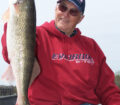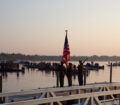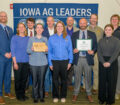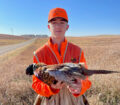By Steve Weisman
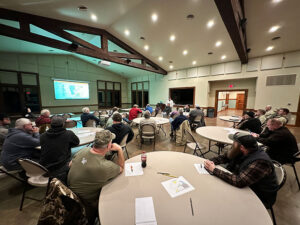
(photo by Nick Lowrey) Over 20 people attended the February 20th DNR meeting for the public at Maser Lodge in Okoboji. The town hall style meeting was one of 18 such meetings across Iowa.
The Iowa Department of Resource (DNR) hosted a total of 18 town hall style meetings on February 20-21 across the state of Iowa to recap hunting, trapping seasons, discuss possible rule changes and to address comments from those who attended the meetings.
In visiting with Todd Bishop, Wildlife bureau Chief for the state of Iowa, after the meetings had been completed, Bishop said, “Feedback from all the meetings was positive with all of them lasting at least two hours, which meant they were having good discussions. All comments were collected and will be compiled, along with comments from those who could not be in attendance. Plus, the bureau does take comments throughout the year.”
At all meetings, a representative from the DNR acted as facilitator of the meeting, while another member wrote down the individual suggestions, questions and summaries of the discussions. At the same time, each meeting site offered a video message from heads of different areas of the wildlife bureau. After each message, the facilitator at each site paused the video to allow time for discussions and questions about that message.
Below are the messages from the DNR’s lead biologists to those in attendance:
Discussion of squirrel, turkey and ruffed grouse
- Jim Coffey, Forest Wildlife Biologist, began the evening covering the small game squirrel, turkey and ruffed grouse populations. Coffey shared that the squirrel hunting continues to decline as it has for the past several years with only about 7% of hunters with a small game license hunting squirrel. Hunters have noted seeing fewer fox squirrels, most likely a habitat response to maturing timber.
- Wild turkey hunting, according to Coffey, “Offers a lot of opportunities in the spring, which is a nontraditional time of the year for most hunters. The spring of 2023 was a record harvest recorded in the state of Iowa with 14,800 birds harvested. Approximately 54,500 tags were purchased, an increase of 2,000 from 2022.” This most likely coincided with the third straight year of increased production across the state. The fall season, meanwhile, is not as highly utilized by hunters. Between 7,000-8,000 hunters buy a license in the fall. Coffey then shared slides of the annual Summer Turkey Survey in July/August of 2023, which is broken down across the agricultural regions of Iowa with seven of those nine regions showing an increase above the five-year average for nest success and poult production.
- Ruffed grouse is limited to northeast Iowa, the driftless region of the state, and with the few numbers of hunters, it is difficult to get a good reading on how much hunting is being done and what the success rate is.
Discussion of pheasant season
- Todd Bogenschutz, Upland Game Biologist, shared some good news about the 2023 pheasant season. The population survey information with pheasant and partridge numbers both showed increases across the state, while quail and cottontail rabbits remained virtually the same as in 2022.
- 2023 found the pheasant harvest to be around 330,000 birds, the most of any state except for South Dakota.
- It is still a far cry from the “CRP” days, and the loss of habitat has mirrored decline in pheasant harvest. Bogenschutz noted, “Habitat is really the elephant in the room for us!”
- As always, it comes down to habitat and weather being the key determiners in the pheasant population.
- There is concern from resident pheasant hunters about the increase in non-resident hunters. As pheasant numbers have increased, the number of non-resident hunters has increased. One of the discussions at the meetings was whether Iowa could go to a “first” week resident-only season before the non-residents could hunt, something like what South Dakota does.
- Bogenschutz says this has been forwarded on to the Natural Resources Commission.
- 2023 will be the 100th year of pheasant hunting in Iowa.
Furbearer – trapping season
- Vince Evelsizer, State Furbearer Biologist, discussed the furbearer populations and the trapping seasons.
- For the most part, populations are stable to increasing except for the muskrat and gray fox.
- Fur prices continue to be depressed, except for beaver prices, which equates to fewer furharvesters and fewer animals taken.
- Two pilot programs are being initiated to pinpoint why numbers are decreasing: Muskrat Pilot Project (a 13-state project) and the Gray Fox Pilot Project.
Waterfowl season
- Orrin Jones, Waterfowl Biologist, discussed the decline of the continental duck populations based on surveys by the Fish and Wildlife Service and the Canadian Wildlife Service. All species were below the long-term average, and mallards in particular because of the widespread drought. This directly resulted in a lack of quality marshland habitat available for migration. This was expanded throughout the Mississippi Flyway. Much of Iowa was part of this drought issue.
- The combination of lower population numbers and drought conditions resulted in below average migration through Iowa this past fall. In the DNR’s fall migration survey, 7 of 17 weeks were below the long-term average, and the total ducks counted was the second lowest in the last 10 years.
- The result? Fewer places to hunt and fewer birds coming through.
- Still, the 16-day teal season hunters fared reasonably well, was supported by three weather systems that improved the numbers of migrating teal.
- 2024 preview shows very little change to regulations, except for a few adjustments to dates because of calendar date changes. Will still be a 16-day teal season., a 9-day metropolitan Canada goose season, regular duck and goose seasons will be very similar.
- Plans are for looking to the 2026-2030 waterfowl hunting zones and season structure, which will include data collection and public meetings for public input. This will be submitted to the US Fish and Wildlife Service for review and, hopefully, approval.
Deer seasons
- Jace Elliot, State Deer Biologist, shared an update on deer harvest, population trends and disease status for 2023 and proposed changes for 2024.
- Hunters reported just over 104,000 deer harvested in 2023, which was down 5% from 2022 and 2% below the 5-year average. Still, Elliot said, “Even though they are down a bit, we are still holding a very stable statewide deer harvest over the last decade.” Northcentral and Eastern Iowa, the county averages were up, likely because of recovering deer populations in the Northcentral area and relatively low Epizootic Hemorrhagic Disease (EHD) activity in East central Iowa. Western third of Iowa deer populations were down substantially, as was the Southern region but not as bad as the Western region.
- EHD was most likely the reason for these declines, and data shows that mortality from EHD was the second highest in Iowa’s history with close to 2,000 reported deaths. It was especially bad in southern Iowa. At least 77 counties were affected by this disease.
- Chronic Wasting Disease (CWD) continues to spread and reached five new counties: Marshall, Guthrie, Monroe, Howard and Jones.
- Proposed rule changes for 2024. First, increase county antlerless tags in Webster, Boone, Hardin, Floyd and Butler counties due to the expanding deer populations. Proposing quota decreases in Monroe, Harrison, Pottawattamie, Case, Montgomery, Adams and Page, while adding a Buck-only restriction during the first gun season in Monona, Harrison, Shelby, Pottawattamie, Mills and Fremont counties. According to Elliot, “The regulatory proposals are in response to a declining deer population that we’ve detected throughout western Iowa over the last decade. By limiting doe harvest in these areas, we’re hoping to allow deer herds to recover over time. Deer hunters in western Iowa should look for upcoming public meetings this population decline and learn more about what we can all do to improve this situation.”












